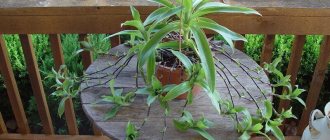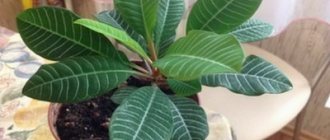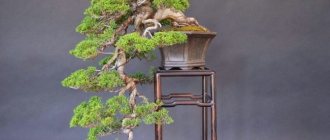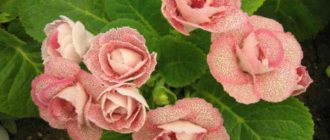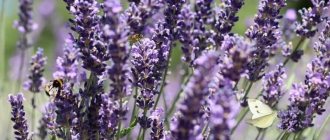Biological description and photo
This perennial plant is a small but rather lush bush that grows up to 25-30 cm in height. As a rule, tiger begonia produces a lot of leaves that completely cover the stems. Thanks to this, a pleasant effect of a unique green pillow is created, which attracts the eye and lifts the mood of its owner.
Here, for example, is what a typical representative of tiger begonia looks like.
The foliage is small, up to 3-4 cm in width, although there are also larger species. The patterns are varied and always contain contrasting elements: alternating stripes, spots or a complex pattern in the form of symmetrical veins diverging from the center to the edges. The shape is round, ovoid, and sometimes complex: reminiscent of oak leaves.
Thanks to its unique color, the flower can be easily distinguished from dozens of species of other plants. Even in the photo of tiger begonia you can see how it benefits due to its unique pattern and contrasting transitions.
If you look closely at the leaves, on many of them you will notice small whitish hairs located along the edges. This fluff gives the plant its charm: it seems that this is a real masterpiece created by nature itself. And white fluff in combination with a tiger pattern evokes associations with tropical exoticism, which also lifts the mood well.
The plant blooms with small white flowers. In appearance they resemble a butterfly and look quite cute. Although, of course, the main source of inspiration is the original leaves. In addition, they will definitely be able to please all year round, and not from time to time.
Bauer's begonia and a little history
This plant is a hybrid species - it was bred in the 1970s. Moreover, tiger begonia is also called Bauer begonia (Begonia Bowerae) in honor of the German breeder Rudolf Bauer.
Interestingly, he also developed the so-called yoshta - a hybrid of black currant and gooseberry. And yet, judging by the photo, Bauer’s begonia can most likely be called tiger begonia.
Description
Bauer's begonia, also known as tiger, belongs to the decorative deciduous species of these plants, whose beauty is not in the abundant and bright flowering, but in the unusual color of the foliage, which forms a compact rounded bush up to 30 cm in height.
Tiger begonia blooms with small white flowers collected in inflorescences. Peduncles grow directly from the roots, which are located on the surface of the soil. The most common flowering period is during the winter months, but most gardeners usually remove the inflorescences before they bloom. This is done so that the plant’s energy is not spent on maintaining flowers and planting seeds to the detriment of the beauty of the foliage.
Home care
In fact, any advice or specific practical recommendation for caring for a plant can be reduced to one golden rule. The gardener should take into account where this plant comes from and try to create environmental conditions that are as close to natural as possible.
In the case of tiger begonia (as with all other representatives of begonia), you must always remember that the flower came to our northern latitudes from the tropics. This means that he really loves moisture and warmth.
Watering and humidity
On the other hand, love for humidity does not mean that tiger begonia needs to be literally filled with water. Excess moisture usually leads to root rot and can even cause the death of the plant.
This means that there is a second golden rule that works perfectly in almost any situation: “everything is good in moderation.”
In this case, pay attention to the following tips:
- Water the Bauer begonia only with settled water - it should stand on the table all night.
- Water is poured only at the root, being careful not to touch the foliage: droplets of moisture can lead to sunburn.
- In summer, water 3-4 times a week, in winter - 2 times less often. The criterion is the top layer of soil: if it is barely moist, you need to add a new portion of water.
- 1-2 days after watering, it is better to loosen the soil so that air can flow freely to the roots.
- And one more rule for gardeners living in areas with too hard water. This liquid is not suitable for irrigation. Therefore, it is preferable to soften it before settling - for example, add a little peat to the container or add melted rainwater. But under no circumstances should you water with boiled water - there is no oxygen in such water.
Among the rules for caring for a flower, one can highlight the fact that Bauer begonia loves moist air. You can create it at home in different ways:
- For example, put moss and wet it (you can also use peat).
- In extreme cases, you can dampen a towel or sponge.
- Another option is to pour water into a saucer and place it on the windowsill.
- Such methods should definitely be used in the summer, during the hot season. And in winter, you can simply ensure regular watering.
NOTE
But you should not spray the foliage of tiger begonia. The fact is that all begonias are capricious ladies. And even small droplets of water lead to the appearance of spots on the surface (due to sunburn). And then the appearance of the plant loses its attractiveness.
Temperature and lighting
As for temperature, here again you can remember where the plant comes from. In general, you should maintain a fairly high temperature level: optimally +22°C... +23°C. In summer the temperature should not fall below +20°C, in winter it can be a little lower, but at least +17°C.
But with lighting the issue is more delicate. It is clear that almost any tropical flower loves the sun. But in the case of Bauer's begonia, it is important not to overdo it: it does not really like excess light. It is optimal to place the pot either in the southwest or southeast. Moreover, direct sunlight should be avoided:
- You can place the pot on a table next to the window.
- Curtain the window with tulle.
- Place the pot in an area of light shade from other plants.
- And in the summer heat, be sure to keep the flowers away from the hot sun.
Soil composition
Beginning gardeners can purchase a special soil mixture for begonias. Although, if you have all the necessary components, you can make the soil yourself. The same quantities are taken:
- humus;
- peat;
- perlite (a rock that is used specifically for plants);
- coarse sand.
The components are mixed, poured into a regular pot (diameter 15-20 cm) almost to the top. There is no need to pour the mixture flush with the edge - you should step back 1-2 fingers' width.
The fact is that the roots of tiger begonia often crawl to the surface and need to be periodically sprinkled with soil. Accordingly, you should leave some space for this. The material of the pot is chosen arbitrarily.
Plant nutrition
Contrary to popular belief, caring for tiger begonia at home does not involve too frequent application of fertilizers. The plant does not really like excess organic or mineral substances, even if they are beneficial. In fact, the flower is fed only in spring and summer, and no more than once every 4-6 weeks.
They use complex mineral fertilizer, which can be alternated with organic fertilizer. The concentrations indicated in the instructions should be reduced by 1.5-2 times. Moreover, in winter, feeding stops - the tropical beauty needs to rest and gain strength for the new season.
How and under what conditions does it bloom?
Begonia evergreen plant at home and in the garden
Tiger begonia pleases with flowering only if good conditions are created for it during the dormant period. The plant does not like to “wake up” ahead of time.
If begonia does not want to bloom, you need to pay attention to the following factors:
- room air temperature;
- regularity of watering;
- illumination;
- air humidity.
Bauer begonia flowers
If all the parameters for caring for Bauer begonia are within normal limits, but it does not bloom, pay attention to the composition of the soil. It should be nutritious and loose. You can achieve the appearance of buds by changing the soil in the pot. The optimal composition is leaf soil, peat, sand and perlite.
Important! When the begonia has gained color, the pot cannot be moved from one place to another.
Reproduction of tiger begonia
This type of plant reproduces using three methods:
- Cuttings.
- Seeds.
- Dividing the bush.
Cuttings
Moreover, the simplest and most popular method of propagating tiger begonia is by cuttings. The instructions are very simple:
- Cut a healthy-looking medium-sized leaf (the cut is made at an angle of 45°).
- Place the leaf in water - a glass, or a small vase, or a jar. The main thing is that the stem of the leaf should not touch the bottom - this could cause it to rot.
- Place the glass with the leaf in a dark and fairly warm place (from +23°C).
- A couple of weeks later, after the roots appear, you can plant the plant in a pot. At the same time, you don’t need to take a pot that is too large, otherwise all the plant’s strength will go into growth, and it will produce few flowers.
- How to plant a cutting: pour soil into a pot, make a small depression, plant a begonia cutting with roots. All that remains is to lightly press it with your fingers and pour it over.
Growing from seeds
This method is less popular because it requires more attention and care. It is better to purchase seed material in a specialized store. They sell seeds in 2 forms:
- Regular (unprocessed).
- Granulated (in the form of dragees) - they are easier to work with.
Regardless of the type of material, the planting technology is the same (planted at the very beginning of spring):
- The seeds are pre-treated with a 1% solution of potassium permanganate for 30-45 minutes.
- They are then washed and planted in a pre-moistened peat tablet.
- Each tablet is placed on a tray, which is covered with polyethylene or glass.
- Then water is constantly added to the tray so that the surface of the tablet is always moderately moist. The room temperature is at least 20-22oC.
- Normally, the first shoots appear after 2-3 weeks. After the formation of the third leaf, a pick is made.
- They dive again 8 weeks after emergence. At the same time, the sprouts are planted in pots.
Reproduction by dividing the bush
The technology for propagating begonias by dividing the bush is the same for almost all types of begonias.
Reproduction
Tiger begonia propagates from rhizome particles and cuttings. You can use the top of the shoot as a cutting, but a single leaf with a cutting of at least five centimeters will do. Begonia can be propagated at any time, usually in spring or summer.
From an adult plant, cut a healthy leaf with a five-centimeter piece of the cutting and immerse it halfway in the same soil as you prepared for the adult plant. Place the pot in a plastic bag with holes for ventilation and place it in a room with a temperature of at least +17 °C.
The leaf cutting is usually planted in a small pot with a diameter of no more than seven centimeters. In a month, maximum one and a half, you will see young sprouts emerging from the cuttings. And after a month they can be planted in separate pots.
Rhizomes should be planted in low pots. The tops of growth are cut off from them. After the rhizomes take root, the plant is divided. The rooted part is separated from it and planted in another container for flowers. The pot is covered with cellophane with holes for ventilation.
Transplanting into a new pot and rejuvenating the bush
Tiger begonia is a perennial plant, and also has the form of a lush, spreading bush. It is clear that if the rules of care are followed, it grows very quickly and needs constant replanting.
The young bush is replanted every spring until it is 3-4 years old. But a plant older than this age is replanted every 2 years. The basic principle is that each new pot is chosen 4-5 cm larger in diameter than the previous one.
Transplanting a Bauer begonia into a new pot is not that difficult. Visual video instructions will help with this.
Rejuvenation of the bush should be carried out only on adult, mature plants (over 4 years old). To do this, you should completely cut off old, weak leaves, as well as flower buds, which take away quite a lot of moisture and nutrients. If necessary, healthy foliage is also cut off, which clearly spoils the appearance - for example, it protrudes too far beyond the main contour of the bush.
Fertilizing and watering regime
Caring for Tiger begonia will not be difficult. It is enough to remember that the period of active feeding begins in the spring, when the plant awakens and maximum growth is activated. It is worth continuing feeding all summer every week. In winter, reduce the amount of fertilizer to once every 6 weeks. It is recommended to water Bauer begonia as the soil dries out. It is important that the water is settled and soft. In winter, watering is reduced to a minimum. Be careful not to get water on the leaves, otherwise they can be damaged and cause burns. Also, do not spray plants to maintain humidity.
Begonia breeding
Tuberous begonia, the propagation of which does not require much trouble, is propagated in two ways: cuttings and leaves.
You can take cuttings from a mature annual plant. Most often this is the rooting of a stem or, less commonly, leaves cut from an adult flower.
You need to select a section for cutting 9-12 cm long (preferably the upper or middle part of the stem), which should have several active buds.
Leaves are removed, with the exception of 2-3 pieces. Rooting occurs in water at room temperature, where the cutting is placed. After some time, roots appear on the cut of the stem. From this moment the plant is suitable for further cultivation.
In this case, either the whole sheet or part of it can be used. How to propagate with a whole leaf: it is stuck with a cut into damp, loose soil and grows over time. In another case, transverse cuts are made on the sheet plate, ensuring a tight fit, and the sheet is laid out face up on the ground.
When using parts of leaves, you need to follow some rules: it is better to plant each fragment in a separate container, the cut should be in close contact with the soil. You can also resort to laying parts, similar to the method described above with whole sheet plates.
To moisturize, it is sprayed with water; the soil should not be allowed to dry out. When new leaves and shoots appear, a new stage begins - adaptation. This is a long process of accustoming a plant to fresh air by increasing the period of ventilation of the greenhouse.
The sprouts will get stronger and gain strength only after 2-3 months, after which they can be planted in the garden or on the plot.
Photo
Among the diversity and varieties of this beautiful plant there are the following: decorative deciduous, tuberous, flowering, bush. Flower growers are most attracted to begonias Diadema, Naked, Sizolistaya, Mix, Collared, Coral, Fista, Mason, as well as double varieties and varieties with yellow flowers and bright red leaves.
Transplantation and rejuvenation of Bauer begonia
Bauer begonia needs to be replanted every two years. Mature plants need to be rejuvenated by pruning so that the leaves on the plant are larger, flower buds need to be removed.
The leaves of tiger begonia have a very beautiful pattern, so it is better to place it separately so that it looks advantageous among other plants.
To combine, you need to take low-growing flowering varieties and plant them in one container. You can even create a small collection of decorative leafy hybrids of Begonia Rex and Begonia masoniani.
Characteristics and description
Tuberous begonia differs from ordinary begonia in that it can be grown as a garden perennial flower. Moreover, it can be different:
This begonia is ideal for decorating external terraces and balcony niches.
Tuberous begonia has several characteristics that distinguish it from its relatives. One of them is a tuber-shaped root about 5-6 cm. The height of the stem, which grows quite dense and thick, can reach 1 meter.
Another difference is the lush and long-term flowering of bright flowers of various colors, the appearance of which is also very different both in the type of petals (double, non-double, with teeth or fringe on the edges, in a fold), and in the shape itself (similar to roses and peonies, large daffodils, carnation-shaped).
The size of the flowers varies in diameter, and they can also grow in an inflorescence or be solitary - it all depends on the variety.
Attention! The flowering time of tuberous begonia is from late spring to mid-autumn (May-October). That is, the flowers will delight the gardener for a very long time
What is unusual is that tuberous begonia has flowers of different sexes: male flowers are usually larger and brighter, attracting attention, while female flowers are not so striking because their appearance is much more modest and usually has about five smooth petals. Easy care: the plant does not like low temperatures
Ideal for growth and flowering at 16-28 degrees Celsius. To preserve them from frost in mid-autumn, the tubers need to be dug up and stored in a dark place for the winter until spring. Under indoor conditions, it will delight with flowers until December, and then goes into a dormant state.
Care is simple: the plant does not like low temperatures. Ideal for growth and flowering at 16-28 degrees Celsius. To preserve them from frost in mid-autumn, the tubers need to be dug up and stored in a dark place for the winter until spring. Under indoor breeding conditions, it will delight with flowers until December, and then goes into a dormant state.
Pests and diseases of begonia
Aphids grow on stems and peduncles and feed on the sap of the plant, causing harm to it. In addition, it can become a carrier of viruses. You can remove insects manually, but after that you must treat them with a soap solution. Laundry soap can be replaced with shag (infuse 100 g of shag in a liter of water for 2 days). If the aphid has settled for a long time, it is better to use insecticidal preparations.
The presence of fluffy lumps on the leaves indicates the presence of felt insects. To combat parasites, a solution of insecticide with water is used. After wetting a cloth or cotton wool, wipe the plant thoroughly. If felt bugs appear again, treat with undiluted preparation.
The causative agent of gray rot is a fungus from the genus Botrytis. Fungal spores move freely through the air, especially in high humidity. Gray spots form on the leaves and shoots, which subsequently turn into gray rot.
To combat, Bordeaux mixture is used with a concentration of 1%, which needs to be sprayed on the plant. Let's use another solution: dilute 2 g of copper sulfate in a liter of water. The latter can be replaced with laundry soap (20 g).
Lack of care also affects the appearance of the plant.
Begonia should be watered carefully, but if watering is insufficient, the leaves and buds will fall off. The lack of light will also be indicated by leaves that will fade and turn pale.
Bauer's begonia is relatively unpretentious and not capricious to care for. Feels great when transplanted. With a little attention, your home will be decorated with one of the most beautiful representatives of the begonia family.
Diseases and pests treatment methods
When a plant is kept in unsatisfactory conditions, it is damaged by pathogenic microorganisms and insect pests.
Tiger begonia diseases:
- powdery mildew - the disease is caused by a fungus that attacks the plant in conditions of excess moisture. The leaf blades are covered with a light coating. For treatment, the bush is moistened with a fungicide solution or a copper-soap solution;
- gray rot - a disease (brown spots) manifests itself throughout the plant. The bush is treated with a solution of Bordeaux mixture, copper-soap solution, and fungicide solutions.
Pests of tiger begonia:
- aphids - usually damage the stems. It is necessary to treat the bush with an insecticide solution;
- soft scale insect - the length of the insect is up to 4 mm, feeds on plant sap. The bush stops growing and developing. It is necessary to treat with a fungicide solution or garlic infusion.
Reproduction methods
To have a compact bush with bright leaves at home, you don’t have to spend money on buying an adult plant.
All types of begonias, including Bauer's (tiger) begonia, are successfully propagated by almost any part of the plant:
- Rooting of petioles;
- Rooting of the leaf blade;
- By dividing the rhizome.
Before rooting, the too long leaf petiole is shortened to 5-7 centimeters, and a third is cut off from the leaf blade to reduce evaporation. If you use a begonia leaf for rooting, then before placing it on the substrate, it is recommended to make several cuts on the underside in the places where large veins branch - this is where the first young roots will appear. You can even get several young bushes from a leaf broken off from the mother plant by dividing the petiole into several parts and using cut leaf blades.
Let's take a closer look at the rules and some secrets of rooting.
- Firstly: from the mother plant you need to take only healthy, fully developed leaves on thick petioles.
- Secondly: rooting can be carried out in a container with water or in a moist substrate consisting of coarse sand and a certain amount of garden soil. To prevent rotting, it is recommended to add a little wood ash or a little pink solution of potassium permanganate to the water or sand mixture.
- Thirdly, you can speed up the process and increase the efficiency of the result by creating “greenhouse” conditions. To do this, containers with leaves or petioles are placed in a plastic bag or covered with a glass jar on top. A favorable microclimate is created inside such a shelter, with the necessary humidity and without sharp temperature fluctuations.
The rooting process can take from ten days to several weeks. In addition, at this time, plants require regular care: ventilating the greenhouses, moistening the substrate or adding water, preventing rotting and timely planting of parts that have taken root. But this method of propagation has one undeniable advantage - just one plucked leaf is enough to independently grow young rosettes.
Begonia bauer successfully reproduces by dividing the rhizome. At home, this is the fastest and least labor-intensive method. Most often, this can be done during transplantation of an adult bush or by cutting off part of the rhizome protruding above the soil surface, which often occurs in old plants. To prevent infections, it is recommended that all cuts be thoroughly powdered with wood ash, lubricated with ordinary pharmaceutical green paint or a solution of potassium permanganate, and then left for about an hour to allow the wounds to dry.
Begonia reproduces by dividing the rhizome

